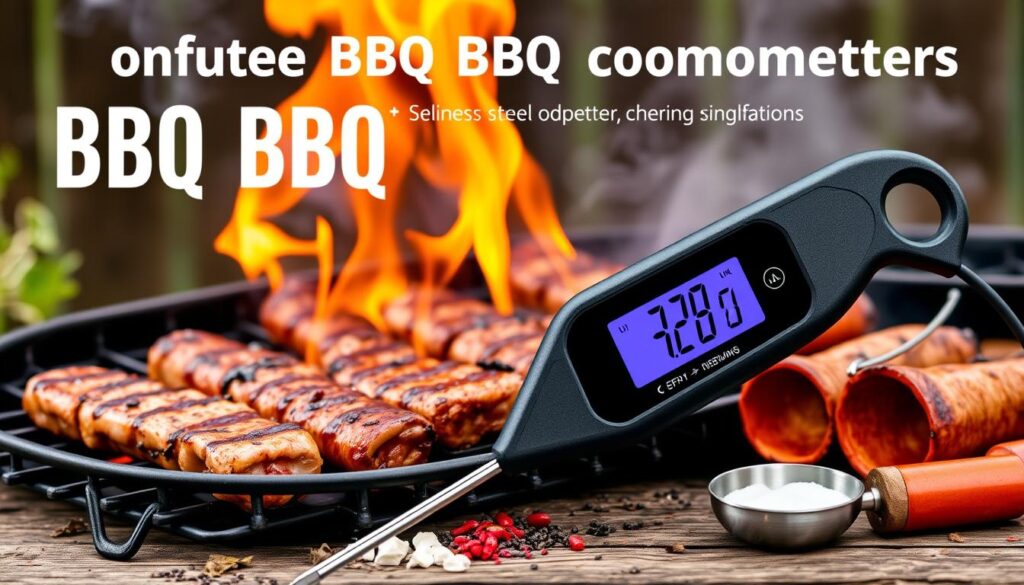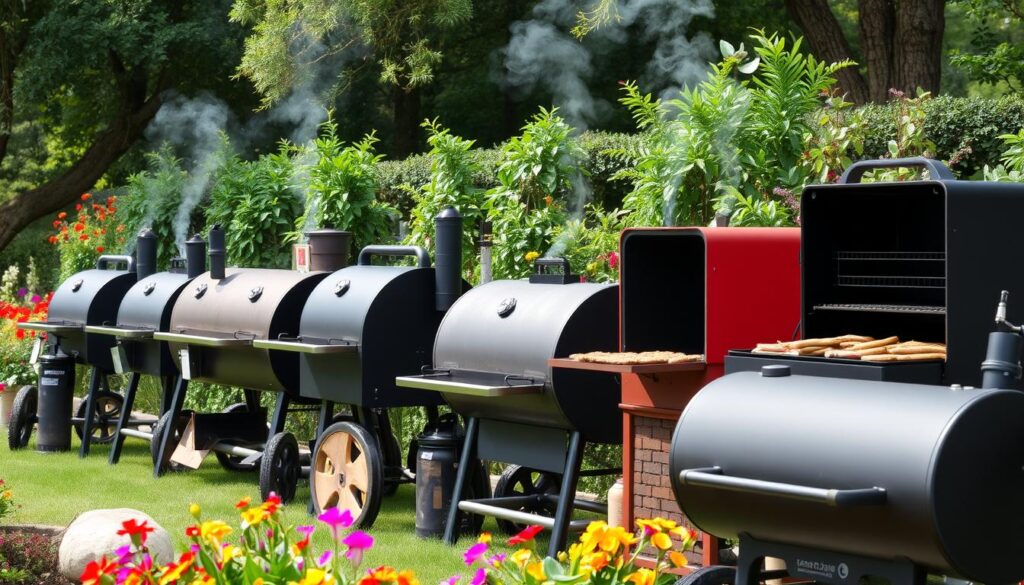Managing Time and Temperature for BBQ Competition Success
Ever wondered what makes BBQ champions stand out? It’s all about controlling time and temperature. Grilling is fun, but competition BBQ requires a deep knowledge of fire, smoke, and slow-cooked perfection.
In BBQ competitions, seconds and degrees matter a lot. They can turn a winning dish into a forgettable one. But don’t worry, this guide will give you the skills to master time and temperature. You’ll be able to take your BBQ skills to the next level and shine in tough competitions.
Key Takeaways
- Understand the fundamental differences between barbecuing and grilling to master the art of low-and-slow cooking.
- Discover the origins and evolution of barbecue as a culinary tradition across the United States.
- Explore the crucial role of temperature control in achieving competition-worthy results with your meats.
- Learn effective strategies for managing multiple smokers and temperature zones to optimize your cooking process.
- Unlock the secrets of time management and advance preparation to excel in the time-constrained environment of BBQ competitions.
Understanding Barbecuing and Grilling
For BBQ lovers, knowing the difference between barbecuing and grilling is key. These terms are often mixed up, but they mean different cooking methods. Each method gives unique results.
The Difference Between Barbecuing and Grilling
Barbecuing cooks meat, fish, and veggies slowly at a low temperature, between 95 and 120 degrees Celsius. This slow cooking lets flavors blend together, making dishes tender and full of taste. On the other hand, grilling cooks food quickly over high heat, between 180 to 350 degrees Celsius. Food is cooked right above the flames or embers.
The Origins of Barbecue
The word “barbecue” comes from the 16th-century Mexican term “barbacoa,” meaning slow-cooking meat in a pit. Over time, barbecue has grown, with each region adding its own twist. From Texas’s smoky flavors to the Carolinas’ tangy sauces, barbecue is a rich tradition.
“Barbecuing is not just a cooking method; it’s a way of life, a celebration of community, and a testament to the power of patience and perfect timing.” – Pitmaster Joe Pearce
Whether you’re a BBQ pro or just starting, knowing the basics of barbecuing and grilling is crucial. It’s the first step to becoming a master of true BBQ.
Mastering Fire and Temperature Control
Being able to control the temperature in your smoker or grill is key to great barbecuing. As a pitmaster, learning how to manage fire and temperature is vital for top-notch results. Let’s look at why temperature matters in barbecuing and how to get it right for perfect cooking.
The Importance of Temperature in Barbecuing
Temperature makes barbecue magic happen. It makes meat tender, adds smoky flavors, and caramelizes the outside. Keeping a steady temperature is crucial for consistent dishes, whether it’s ribs, brisket, or pulled pork. If the temperature changes, meat can dry out or not cook enough.
Managing temperature in a smoker with charcoal or wood is tricky. The type of fuel and airflow control the temperature. By adjusting the dampers, you can change the oxygen flow and the smoker’s temperature.
| Temperature Range | Ideal for Cooking |
|---|---|
| 225°F – 250°F | Low and slow cooking of brisket, pork shoulder, and ribs |
| 300°F – 350°F | Grilling steaks, burgers, and other quick-cooking meats |
| 400°F – 450°F | High-heat searing and caramelization of the exterior |
Keeping a steady temperature is key for top barbecue results. By getting the hang of fire and temperature control, you’ll make delicious, award-winning dishes.
“Temperature control is the foundation of exceptional barbecue. It’s the difference between a tough, dry brisket and a tender, juicy masterpiece.”
Preparing Meats for Competition-Level Barbecuing
For top-notch barbecuing, the meat you pick is key. Pitmasters stress the need for selecting high-quality cuts of meat. This choice is crucial for a great dish, from tender briskets to tasty ribs.
Selecting High-Quality Cuts of Meat
Choose meats that are well-marbled and have a good fat-to-lean mix. This keeps the meat juicy and tender during slow cooking. Stay away from meats with too much connective tissue, as they can become tough.
Marinating and Seasoning Techniques
For top barbecuing, marinating and seasoning techniques are vital. Pitmasters warn against oiling the meat before grilling. Instead, use marinades that soak into the meat and boost its flavor.
Be careful with dry spice mixes on the grill or smoker. The heat can burn the spices, making them taste bitter. Season the meat after cooking, during the resting phase, for the best flavor.
“The key to competition-level barbecuing is understanding the nuances of meat selection, marinating, and seasoning. With the right techniques, you can elevate your backyard grilling to new heights.”
Time and Temperature for BBQ Competitions
In competitive barbecue, getting it right is crucial. Knowing the best cooking temperatures for meats is key to winning. Whether you’re grilling steaks or slow-smoking briskets, the right internal temperatures are vital for top scores.
Optimal Cooking Temperatures for Different Meats
Here are the best cooking temperatures for meats in BBQ contests:
- Beef Brisket: 195°F to 205°F (91°C to 96°C)
- Pulled Pork: 195°F to 205°F (91°C to 96°C)
- Chicken: 165°F to 175°F (74°C to 79°C)
- Ribs: 195°F to 205°F (91°C to 96°C)
- Sausage: 160°F to 165°F (71°C to 74°C)
Reaching these temperatures makes sure the meat is just right. It’s tender and full of flavor, just what judges want.
Precision Temperature Monitoring with Digital Thermometers
For top BBQ results, it’s all about precise temperature control. Digital thermometers with probes are a must. They let you track the meat’s internal temperature closely. This way, you can adjust the heat or airflow to keep the meat at the perfect temperature.

“Precision temperature monitoring is the secret weapon of top BBQ competitors. It’s the difference between a good meal and a Grand Champion-worthy dish.”
Managing Multiple Smokers and Temperature Zones
Cooking for a BBQ competition means handling multiple smokers and temperature zones at once. This can seem tough, but with the right tools and strategies, you can keep a tight grip on your cooking environment.
Using Billows BBQ Control Fans for Temperature Regulation
The Billows BBQ control fan is a great tool for managing temperature in charcoal and wood-fired smokers. These fans automatically feed air to the smoker when the temperature drops below your set range. They slow or stop the air flow when it gets too high. This keeps your cooking steady and consistent, even when you’re working with several smokers and temperature zones.
- Precise temperature control for consistent results
- Automated air flow regulation to maintain optimal cooking conditions
- Compatibility with a wide range of smoker and grill models
Using Billows BBQ control fans removes the guesswork from temperature management. You can focus on perfecting your BBQ recipes. This technology lets you easily keep the perfect cooking environment, even with multiple smokers and temperature zones.
“The Billows fan has been a game-changer for my BBQ competitions. It takes the stress out of temperature control and allows me to devote my attention to crafting the perfect smoked meats.”
Controlling Temperature in Charcoal and Wood-Fired Smokers
Learning how to control the temperature in charcoal and wood-fired smokers is key to winning at barbecue. It’s all about knowing how to adjust airflow and vents, and how to manage the fuel during cooking.
Understanding Airflow and Vent Adjustments
The intake damper controls how much oxygen goes into the smoker. The exhaust damper lets out the gases and extra heat. Getting these vents right is vital for keeping the right cooking temperature. By adjusting the airflow, you can make sure your smoker stays at the perfect temperature for your food.
Fuel Management: Adding Charcoal or Wood During Cooking
Adding more charcoal or wood at the right time can greatly improve temperature control. Keep an eye on the fuel levels and add more as needed. This keeps the temperature steady and prevents your meat from getting ruined.
Mastering temperature control in smokers will help you make delicious barbecue that wins awards. Always pay attention and keep the temperature just right. Your smoker will be your best ally.

“The secret to competition-level barbecue is in the details – and that includes precise temperature management.”
Effective Time Utilization in BBQ Competitions
BBQ competitions require careful time management. Pitmasters know the value of planning and preparation. They use strategies like serving appetizers and side dishes to buy time while the main dishes cook.
Planning and Preparation Strategies
Top BBQ teams put a lot of work into planning and preparing. They might:
- Look over past competition notes to find ways to get better
- Try out new cooking methods and flavors
- Use feedback from past events to improve their recipes
- Make a detailed BBQ checklist to not miss anything important
Serving Appetizers and Side Dishes to Buy Time
Pitmasters know that serving appetizers and side dishes helps them buy time in competitions. These dishes keep judges and spectators happy while the main dishes cook. This way, pitmasters can focus on their cooking without rushing or sacrificing quality.
| Appetizer | Estimated Cooking Time |
|---|---|
| Grilled Shrimp Skewers | 15-20 minutes |
| Smoked Chicken Wings | 30-40 minutes |
| Bacon-Wrapped Jalapeño Poppers | 20-25 minutes |
“Effective time management is the key to success in BBQ competitions. By serving appetizers and side dishes, we can keep our guests satisfied while the main meats continue to cook to perfection.”
Mastering effective time utilization is what sets winners apart in BBQ competitions. By planning well and serving extra dishes, pitmasters make sure their meats get the time they need. This approach helps them impress judges and win the competition.
Using Combi-Steamers for Grilling and Smoking
The world of barbecue and grilling is always changing. Chefs and pitmasters are finding new tools and techniques to improve their skills. Combi-steamers are becoming popular for their precision and versatility in smoking and grilling meats.
Sous-Vide and Low-Temperature Smoking with Combi-Steamers
Combi-steamers are great for low-temperature smoking, similar to traditional barbecue. They keep the temperature and humidity just right. This lets you cook meats that are tender and full of smoky flavor.
Using the sous-vide feature, you can get consistent results every time. This is very important in BBQ competitions where you need to impress judges.
Grilling Accessories for Combi-Steamers
Combi-steamers are not just for smoking. They also work well for grilling with special accessories. You can get grill plates and sear grates that help create the perfect sear on your meats.
With these accessories and the combi-steamer’s precise temperature control, your grilled meats will look amazing. They’ll impress even the toughest judges.

Leave a Reply